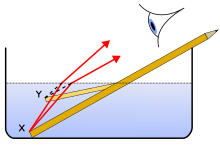Refraction
Refraction is the change in direction of a wave due to a change in its transmission medium.

In optics, refraction is a phenomenon that often occurs when waves travel from a medium with a given refractive index to a medium with another at an oblique angle. At the boundary between the media, the wave's phase velocity is altered, usually causing a change in direction. Its wavelength increases or decreases but its frequency remains constant. For example, a light ray will refract as it enters and leaves glass, assuming there is a change in refractive index. A ray traveling along the normal
(perpendicular to the boundary) will change speed, but not direction.
Refraction still occurs in this case. Understanding of this concept led
to the invention of lenses and the refracting telescope.
REFRACTIVE INDEX
In optics the refractive index or index of refraction n of a substance (optical medium) is a dimensionless number that describes how light, or any other radiation, propagates through that medium. It is defined as
The historically first occurrence of the refractive index was in Snell's law of refraction, n1sinθ1= n2sinθ2, where θ1 and θ2 are the angles of incidence of a ray crossing the interface between two media with refractive indices n1 and n2.
Refraction is the change in direction of a wave due to a change in its transmission medium.

Explanation
REFRACTIVE INDEX
In optics the refractive index or index of refraction n of a substance (optical medium) is a dimensionless number that describes how light, or any other radiation, propagates through that medium. It is defined as
 ,
,
The historically first occurrence of the refractive index was in Snell's law of refraction, n1sinθ1= n2sinθ2, where θ1 and θ2 are the angles of incidence of a ray crossing the interface between two media with refractive indices n1 and n2.


No comments:
Post a Comment